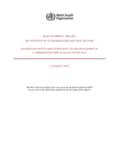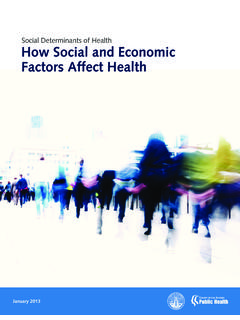Transcription of CHAPTER Conceptual Framework of Health Determinants
1 Conceptual Framework ofHealth Determinants 43 CHAPTER2 Conceptual frameworks are maps con-structed to define the causal rela-tionship between a problem and thefactors contributing to key step inthe understanding of a problem to be stud-ied is the development of a conceptualframework. Wolfson described the impor-tance of a Conceptual Framework when heasserted, Data and facts are not like peb-bles on a beach, waiting to be picked upand collected. They can only be perceivedand measured through an underlying theo-retical and Conceptual Framework , whichdefines relevant facts, and distinguishesthem from background noise. ( )5 AsWolfson s quote describes, the conceptualframework is a preliminary model of theproblem under study, and is reflective of re-lationships among critical variables of in-terest.
2 Conceptual frameworks on healthhave transgressed over time as our under-standing and values of Health Conceptual frameworks onhealth care systems, specifically those fo-cusing on the United States, encompass abroad range of problems, including the so-cial, environment, and structural factors im-pacting the quality and quantity of healthacross populations. Yet, within this diverseproblem set lies the commonality of healthequity as the proposed solution to address-ing our Health care begin with, in order to successfullyunderstand Conceptual frameworks theremust be a clear definition of how the vari-ous identified factors contributing to aproblem relate to each promi-nent Conceptual frameworks categorize fac-tors into distinct levels, with the factor atone level leading to the causation of a fac-tor at the next level.
3 For example, in a con-ceptual Framework on the environment simpact on Health , it is the absence of re-served open space that leads to the imple-mentation of industrial factories, which inturn lead to the development of poor airquality and adverse Health ,3 However, rarely do discrete levels exist infactors contributing to Health , these elements continu-ously penetrate the Health of a populationthrough interconnected pathways, resultingin the fluid decrease or improvement ofhealth over , while the industrialfactories lead to poor air quality, they alsolead to an increase in jobs and economicwealth for a community, thereby acting aspart of an interconnected pathway of bothpositive and negative Health ,3 Nancy Krieger s article Proximal, Distal 8/23/10 3:45 PM Page 43 Jones & Bartlett Learning, LLC.
4 NOT FOR SALE OR DISTRIBUTIONthe Politics of Causation, proposes that, with a shiftof language, Conceptual frameworks can more accu-rately represent this degree Krieger, spatial defining terminology should be re-placed with terms like levels and pathways to moreaccurately represent the relationships of social de-terminants of is not the distinct presenceor absence of an element causing poor Health out-comes, but, rather, how the elements interconnectwith each other to cause an adverse impact on a pop-ulation s , the most prominent Conceptual frame-works is that proposed by the World Health Organiza-tion s (WHO) Commission on Social Determinantsof Framework is distinguished due to itsability to identify the structural Determinants of healthinequities, and the impact of power and governmentinfluence on population Health .
5 structural determi-nants encompass those that stratify individuals intosocial classes of hierarchical power, including income,education, gender and Commission con-nects these structural Determinants to the resultinginequity in Health through intermediary Determinants ,material circumstances, biological factors, behaviorsand psychosocial factors. These intermediary bene-fits are supported by the social capital and social co-hesion of society, including the norms, social trustand networks that facilitate coordination of Commission concludes its frameworkby stressing the integration of structural determinantsin policy formulation addressing social determinantsto effectively address the inequities of Health WHO Conceptual Framework transcribesto national frameworks on environmental condi-tions impacting the quality of Health across ,3 One example of a Conceptual frameworkcontextualizing the impact of the environment onhealth is Northridge et al.
6 S work, as described inSorting Out the Connections Between the BuiltEnvironment and built environment ischaracterized as the environment built by peoplefor people, the product of urban planning effortsto provide livable settings for contextualizes how modifications madeto the natural environment by urban planning trans-late into built environmental stressors that ulti-mately influence individual Health mirrors the outcomes established by theWHO commission, including the impact of powerand government intervention on the Health out-comes of ,3 Those most susceptibleto poor built environments are those with the leastpower, alluding to government intervention as theonly measure to ensure adequate environmentalstandards within a given ,3 Additionally, in order to fully represent domi-nant frameworks in Health care, a conceptualframework identifying the prominent structural chal-lenges in delivering efficient Health care services mustbe et al.
7 Defines a frameworksurrounding waste in the Health care system inthe article Waste in the Health Care System: AConceptual Framework success-fully defines the venues in which Health care wasteflows, including administrative, operational and clin-ical waste is characterized asany spending on administrative activities that ex-ceeds what is necessary to achieve the organization sgoals, such as insurance product design and excessclaims waste is character-ized as any unnecessary use of resources in the pro-duction or delivery of Health services, includingincreased patient waiting times and medical waste can be defined as any spending to pro-duce services that provide little to no marginal healthbenefit over less costly alternatives, excessive diag-nostic testing and lost medical , aswith environmental frameworks.
8 Conceptual frame-works on structural problems in Health care mir-ror the proposed contexts set forth by the ,3,4 The most vulnerable to being col-lateral damage to Health care waste are those with theleast power, suggesting to the need for governmentaction to ensure population ,4 Conceptual frameworks are only as useful astheir ability to induce action into finding solutionsfor the defined frameworks arebest utilized by those possessing the power to inducechange in communities and among populations aswell as those committed to implementing referenced by Bentley et al. in discussions of con-ceptual frameworks on waste in the Health caresystem, while the problems are easily identified thepotential fixes are much more CHAPTER includes four readings that illustratewhat a Conceptual Framework is and how conceptualframeworks might be used to understand Health andhealth care problems and identify solutions.
9 InProximal, Distal and the Politics of Causation:What s Level Got To Do With It?Krieger proposesthat a relative shift in terminology is needed in orderto advance public Health science. Historically, publichealth frameworks on social Determinants utilizedproximal and distal terminology to define, and cate-gorize, distinctions among social and economic fac-tors in relationship to an individual s Health . Proximaland distal terminology has allowed biological and so-44 CHAPTER 2 CONCEPTIONAL Framework OF Health 8/23/10 3:45 PM Page 44 Jones & Bartlett Learning, LLC. NOT FOR SALE OR DISTRIBUTION cial sciences to define the spatial location and relativeimportance of factors describing disease to Krieger, spatial defining terminologyshould be replaced with terms like levels and path-ways to more accurately represent the relationships ofsocial Determinants of Health .
10 Unlike proximal anddistal events, which occur sequentially through timeand space, social Determinants are interconnected,existing simultaneously in causal relationships thatimpact an individual s Health . For example, as Kriegerexamines within her paper, in order to fully analyzethe Health consequences embodied within tobaccoproducts, one must study both the biological ecologyand political economy as they simultaneously relateto each other. A cigarette is simultaneously: (1) a flam-mable mass of carcinogens providing toxic elementsto human lungs upon inhalation; and (2) a productwhose high profitability relies on the intentional pro-duction and marketing to lower socioeconomicclasses. To not recognize the dual biological and so-cial existence of cigarettes would provide an incom-plete illustration of the impact of tobacco products onthe public s Health .













